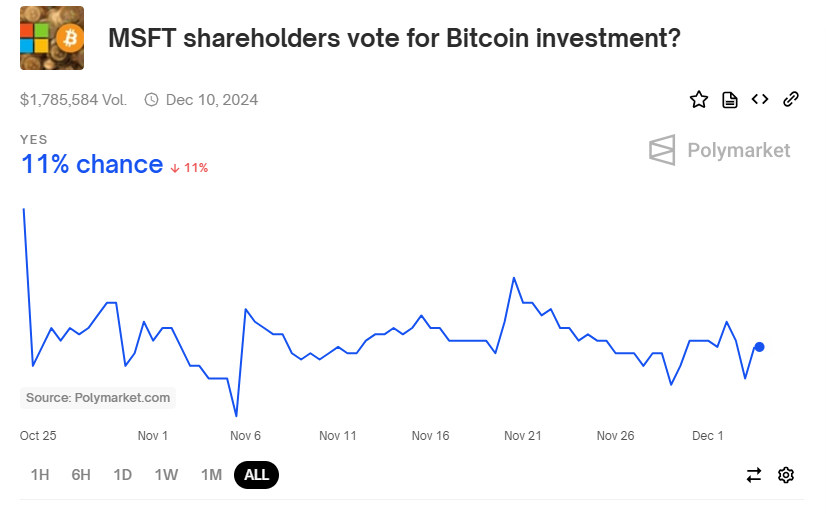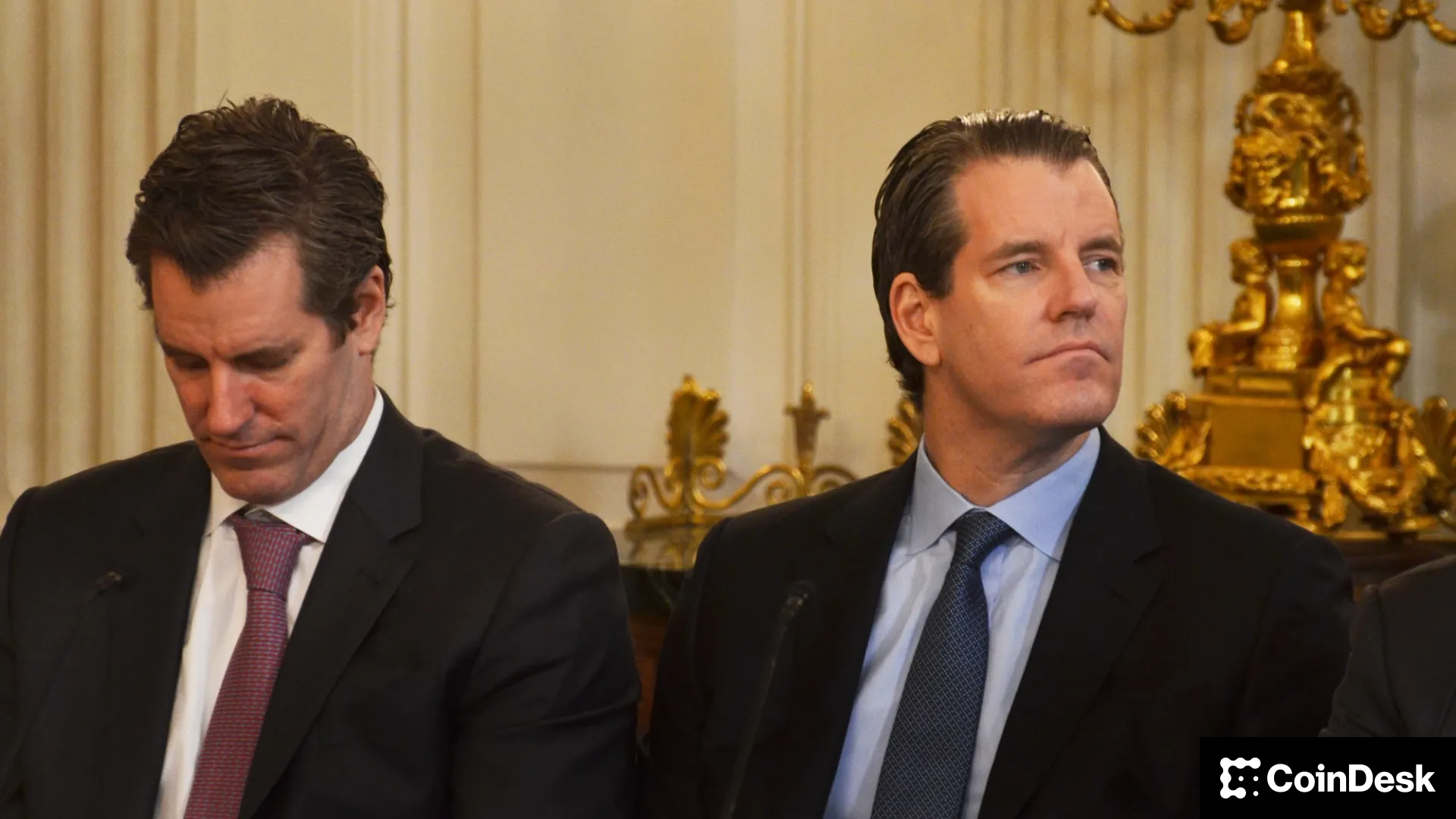Uncategorized
Polymarket Bettors Skeptical Over Potential Microsoft (MSFT) Bitcoin Purchase

Michael Saylor’s pitch to Microsoft’s (MSFT) board on whether the software giant should add bitcoin to its balance sheet is unlikely to get shareholder approval, with <a href=»https://polymarket.com/event/will-microsoft-shareholders-vote-for-bitcoin-investment?tid=1733211064555″ target=»_blank»>Polymarket bettors</a> only giving an 11% chance of it being approved.

Each bet comprises a «Yes» and a «No» side. Each share pays out $1 in USDC, a stablecoin, or cryptocurrency that trades at par with the U.S. dollar, if the prediction comes true, and zero if not.
In October, a <a href=»https://www.coindesk.com/business/2024/10/24/microsoft-urges-shareholders-to-vote-against-a-proposal-to-assess-bitcoin-as-a-diversification-investment-filing» target=»_blank»>proposal from the National Center for Public Policy Research</a> urged Microsoft to add bitcoin to its balance sheet as a diversification investment, but the board recommended shareholders vote against it, arguing that crypto lacked the stability to be part of the treasury of a company the size of MSFT.
Saylor, the executive chairman of Microstrategy (MSTR), which has seen its stock rocket up 455% year-to-date, <a href=»https://www.coindesk.com/markets/2024/12/02/micro-strategy-added-15-4-k-bitcoin-for-1-5-b-taking-total-holdings-to-402-100-tokens» target=»_blank»>recently pitched</a> Microsoft’s board on this issue, arguing bitcoin could act as a hedge against inflation and economic uncertainty, potentially boosting Microsoft’s $3.2 trillion market cap to over $8 trillion.
Microsoft’s current treasury strategy, Saylor says, is weakening the company, as it has «surrendered» $200 billion in capital over five years through dividends and buybacks, which he argued could have been invested in Bitcoin, now up over 1,200% in that period.
One Polymarket bettor argued that there wasn’t really a point for institutional investors to want Microsoft to add bitcoin to its balance sheet, because there are already so many options out there to get bitcoin exposure – which wasn’t the case when Microstrategy originally bought.
«They’re just making their value assessment more difficult by muddying up safe investments (MFST) with volatile ones (BTC),» <a href=»https://polymarket.com/profile/0x79add3f87e377b0899b935472c07d2c3816ba9f1″ target=»_blank»>trader Oxymirin wrote</a>, who holds a position on the ‘no’ side worth $2000.
Another bettor, who holds the opposite side of the trade, argued that given Microsoft’s comfortable cash position, the company might buy a small amount of BTC.
«I think a small amount of funds will be allocated for testing. After all, shareholders’ rights must be taken into consideration. Microsoft’s cash position is sufficient. Microsoft offers some options for buying Bitcoin,» a <a href=»https://polymarket.com/profile/0xb7e5f664261d08262554a350fb45ae012d14b7b6″ target=»_blank»>trader that goes by the handle of titanlin</a> wrote.
Microsoft is scheduled to hold its next shareholder meeting on December 10, where the motion will be voted on.
Business
Crypto Trading Firm Keyrock Buys Luxembourg’s Turing Capital in Asset Management Push

Crypto trading firm Keyrock said it’s expanding into asset and wealth management by acquiring Turing Capital, a Luxembourg-registered alternative investment fund manager.
The deal, announced on Tuesday, marks the launch of Keyrock’s Asset and Wealth Management division, a new business unit dedicated to institutional clients and private investors.
Keyrock, founded in Brussels, Belgium and best known for its work in market making, options and OTC trading, said it will fold Turing Capital’s investment strategies and Luxembourg fund management structure into its wider platform. The division will be led by Turing Capital co-founder Jorge Schnura, who joins Keyrock’s executive committee as president of the unit.
The company said the expansion will allow it to provide services across the full lifecycle of digital assets, from liquidity provision to long-term investment strategies. «In the near future, all assets will live onchain,» Schnura said, noting that the merger positions the group to capture opportunities as traditional financial products migrate to blockchain rails.
Keyrock has also applied for regulatory approval under the EU’s crypto framework MiCA through a filing with Liechtenstein’s financial regulator. If approved, the firm plans to offer portfolio management and advisory services, aiming to compete directly with traditional asset managers as well as crypto-native players.
«Today’s launch sets the stage for our longer-term ambition: bringing asset management on-chain in a way that truly meets institutional standards,» Keyrock CSO Juan David Mendieta said in a statement.
Read more: Stablecoin Payments Projected to Top $1T Annually by 2030, Market Maker Keyrock Says
Business
Crypto Trading Firm Keyrock Buys Luxembourg’s Turing Capital in Asset Management Push

Crypto trading firm Keyrock said it’s expanding into asset and wealth management by acquiring Turing Capital, a Luxembourg-registered alternative investment fund manager.
The deal, announced on Tuesday, marks the launch of Keyrock’s Asset and Wealth Management division, a new business unit dedicated to institutional clients and private investors.
Keyrock, founded in Brussels, Belgium and best known for its work in market making, options and OTC trading, said it will fold Turing Capital’s investment strategies and Luxembourg fund management structure into its wider platform. The division will be led by Turing Capital co-founder Jorge Schnura, who joins Keyrock’s executive committee as president of the unit.
The company said the expansion will allow it to provide services across the full lifecycle of digital assets, from liquidity provision to long-term investment strategies. «In the near future, all assets will live onchain,» Schnura said, noting that the merger positions the group to capture opportunities as traditional financial products migrate to blockchain rails.
Keyrock has also applied for regulatory approval under the EU’s crypto framework MiCA through a filing with Liechtenstein’s financial regulator. If approved, the firm plans to offer portfolio management and advisory services, aiming to compete directly with traditional asset managers as well as crypto-native players.
«Today’s launch sets the stage for our longer-term ambition: bringing asset management on-chain in a way that truly meets institutional standards,» Keyrock CSO Juan David Mendieta said in a statement.
Read more: Stablecoin Payments Projected to Top $1T Annually by 2030, Market Maker Keyrock Says
Business
Gemini Shares Slide 6%, Extending Post-IPO Slump to 24%

Gemini Space Station (GEMI), the crypto exchange founded by Cameron and Tyler Winklevoss, has seen its shares tumble by more than 20% since listing on the Nasdaq last Friday.
The stock is down around 6% on Tuesday, trading at $30.42, and has dropped nearly 24% over the past week. The sharp decline follows an initial surge after the company raised $425 million in its IPO, pricing shares at $28 and valuing the firm at $3.3 billion before trading began.
On its first day, GEMI spiked to $45.89 before closing at $32 — a 14% premium to its offer price. But since hitting that high, shares have plunged more than 34%, erasing most of the early enthusiasm from public market investors.
The broader crypto equity market has remained more stable. Coinbase (COIN), the largest U.S. crypto exchange, is flat over the past week. Robinhood (HOOD), which derives part of its revenue from crypto, is down 3%. Token issuer Circle (CRCL), on the other hand, is up 13% over the same period.
Part of the pressure on Gemini’s stock may stem from its financials. The company posted a $283 million net loss in the first half of 2025, following a $159 million loss in all of 2024. Despite raising fresh capital, the numbers suggest the business is still far from turning a profit.
Compass Point analyst Ed Engel noted that GEMI is currently trading at 26 times its annualized first-half revenue. That multiple — often used to gauge whether a stock is expensive — means investors are paying 26 dollars for every dollar the company is expected to generate in sales this year. For a loss-making company in a volatile sector, that’s a steep price, and could be fueling investor skepticism.
-

 Business11 месяцев ago
Business11 месяцев ago3 Ways to make your business presentation more relatable
-

 Fashion11 месяцев ago
Fashion11 месяцев agoAccording to Dior Couture, this taboo fashion accessory is back
-

 Entertainment11 месяцев ago
Entertainment11 месяцев ago10 Artists who retired from music and made a comeback
-

 Entertainment11 месяцев ago
Entertainment11 месяцев ago\’Better Call Saul\’ has been renewed for a fourth season
-

 Entertainment11 месяцев ago
Entertainment11 месяцев agoNew Season 8 Walking Dead trailer flashes forward in time
-

 Business11 месяцев ago
Business11 месяцев ago15 Habits that could be hurting your business relationships
-

 Entertainment11 месяцев ago
Entertainment11 месяцев agoMeet Superman\’s grandfather in new trailer for Krypton
-

 Entertainment11 месяцев ago
Entertainment11 месяцев agoDisney\’s live-action Aladdin finally finds its stars




